Time 08:46 GMT Cause Driver failed to stop Passengers 300 Number of deaths 43 Injuries 74 | Country England Trains 1 Date 28 February 1975 Passenger count 300 | |
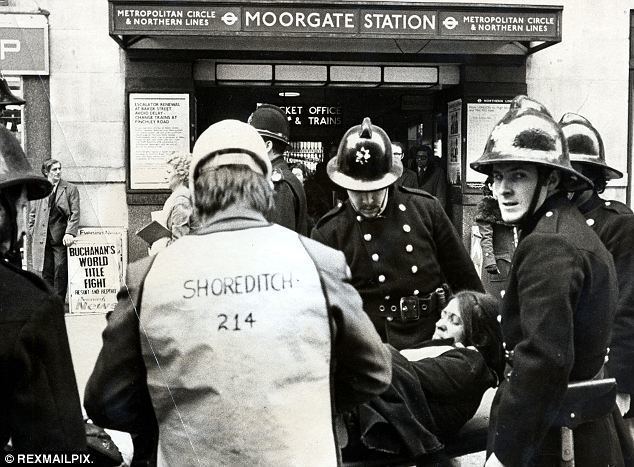 | ||
Rail line Northern Line (Highbury Branch) Similar Clapham Junction rail crash, Ladbroke Grove rail crash, Lewisham rail crash, King's Cross fire, Harrow and Wealdsto | ||
Synd 1 3 75 aftermath of the moorgate tube crash
The Moorgate tube crash occurred on 28 February 1975 at 08:46 GMT on the Northern City Line, then operated by London Underground as the Highbury branch of the Northern line. A train failed to stop at the Moorgate station, the line's southern terminus, and crashed into the wall at the end of the tunnel. In the greatest loss of life during peacetime in the London Underground, 43 people died and a further 74 were injured. With no fault being found with the train equipment, a report from the Department of the Environment found that the driver had failed to slow the train and stop at the station and there was insufficient evidence to determine the reason.
Contents
- Synd 1 3 75 aftermath of the moorgate tube crash
- Collision
- Rescue
- Report
- Legacy
- Moorgate protection
- Memorials
- References

Following the crash, a safety system that stops a train automatically if the driver fails to brake was introduced on the London Underground which became informally known as Moorgate protection.
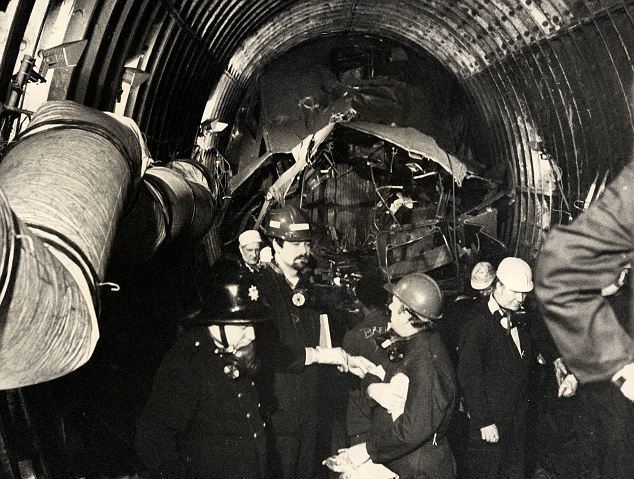
Collision
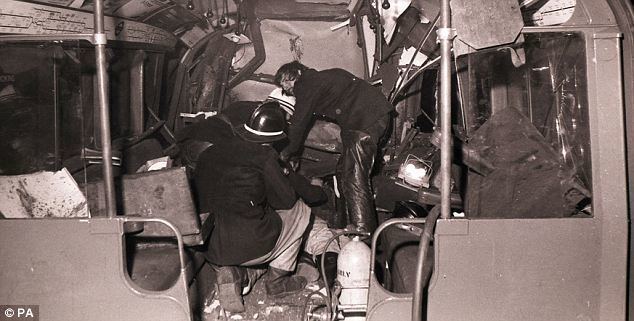
On Friday, 28 February 1975, the 08:38 service from Drayton Park on the Northern line's Highbury branch left one minute late. Formed of two three-car units of 1938 tube stock, on arrival at the station, the train failed to slow, passing through the station at 30–40 mph (48–64 km/h), before entering the 66-foot (20 m) long overrun tunnel with a red stop-lamp, a sand drag and hydraulic buffer stop. The sand drag only slowed the train slightly, before the train collided heavily with the buffers and then the wall.
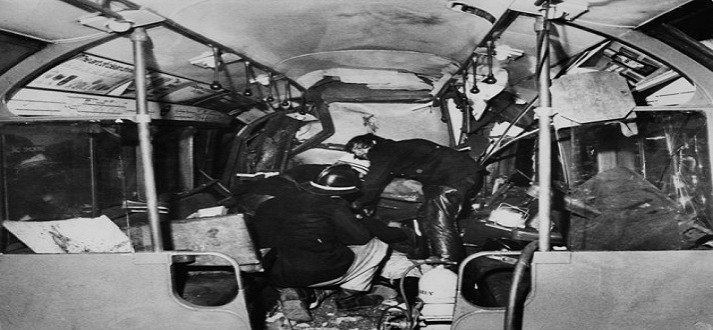
The Highbury branch tunnels were built to accommodate surface line loading gauge trains and were 16 feet (4.9 m) high. The smaller diameter of the tube train involved allowed the first car to ride up over the hydraulic buffers, with the second coach driving under the first, leading to significant damage at this end. The leading driving car buckled at three points into a V shape and was crushed to less than half its length between the wall and the weight of the train piling up behind it. The third car was damaged at both ends, more significantly at the leading end as it rode over the second car. Approximately 300 passengers were on the train: 42 passengers and the driver died and 74 passengers were treated in hospital for their injuries.
Rescue
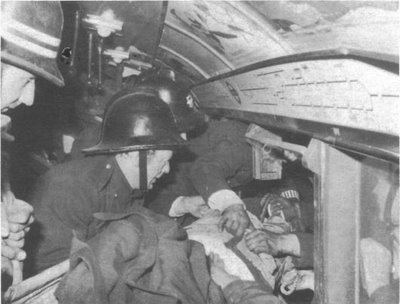
Emergency services were called at 08:48, the first ambulances arriving at 08:54 and the fire brigade at 08:58. The Post Office organised impromptu telephone lines in the station for the emergency services.
On arrival at the site of the accident the members of the (surgical) team made their way towards the front of the train, where they were confronted with scenes of utter devastation beyond their previous experience. The third carriage had been cleared of all but one live casualty trapped by her limbs. This passenger was successfully released about one hour later by the surgical member of the resuscitation team. The second carriage had been cleared of the living but there were several victims who were trapped and obviously dead. The front carriage was an indescribable tangle of twisted metal and in it the living and the dead were heaped together, intertwined among themselves and the wreckage.
It was impossible to estimate the number involved with any degree of accuracy because the lighting was poor, the victims were all tangled together, and everything was covered with a thick layer of black dust. Many of the victims were writhing in agony and were screaming for individual attention. It was obvious from an early stage that the main problem was the disentanglement of a heap of people, many of whom appeared to be in imminent danger of suffocation.
Rescue was very difficult, with the last survivor not being freed until 22:05, over thirteen hours after the collision. At least two victims died of Crush syndrome soon after being released alive from the wreckage. The last body recovered was that of the driver and this was not removed until 20:00 on Tuesday, 4 March 1975. Services on the short line were suspended on the day of the impact, followed by a shuttle service between Drayton Park and Old Street until normal traffic returned on 10 March 1975.
Report
A memorial plaque is affixed to the side of the station building, in Moor Place.The Department of the Environment report on the collision was published on 4 March 1976 and tests showed no equipment fault on the train. Postmortem evidence indicated that, at the time of impact, the driver's hand was on the "dead man's handle", rather than in front of his face to protect it, implying he had made no attempt to stop. Witnesses were interviewed; some passengers on the train reporting that the train accelerated when entering the station, and some witnesses standing in the station reported that the driver, 56-year-old Leslie Newson, was sitting upright in his seat and looking straight ahead as the train passed through the station. The state of the motor-control gear, as found after the accident, indicated that power had been applied to the motors until within two seconds of the impact.
Newson had worked for London Underground since 1969 and the post-mortem examination did not find any evidence of a medical problem, such as a stroke or heart attack, that could have incapacitated him. There was some doubt as to whether he had consumed alcohol. Testing for this was hampered by the four-and-a-half days it took to retrieve his body from the wreckage. Analysis showed that his blood alcohol level, at the time of the post-mortem, was 80 mg/100ml, but it was not possible to reach a definite conclusion as to whether this was the result of consumption of alcohol or a product of the process of decomposition. 80 mg/100ml is the current UK legal limit for driving a car (the limit at the time of the accident was higher), and the medical experts disagreed with each other on whether any amount consumed would have affected his ability to drive the train. Medical evidence to the official inquiry raised the possibility that the driver had been affected by a condition such as transient global amnesia, or akinesis with mutism, where the brain continues to function and the individual remains aware, although not being able to move physically, but it was stated that there was no evidence to indicate either condition: to positively diagnose akinesis with mutism would depend on a microscopic examination of the brain, which was not possible owing to decomposition, and transient global amnesia would leave no traces at post-mortem in any case.
Evidence to the inquest showed that the driver had over £270 (about £1800 today) in his pocket, which he was intending to use to purchase a car for his daughter after the end of his shift and no evidence of suicidal intent was proven. The coroner's verdict was accidental death. The Department of the Environment report found that there was insufficient evidence to say if the accident was due to a deliberate act or a medical condition. The writer Laurence Marks, whose father died in the disaster, presented a Channel 4 documentary Me, My Dad and Moorgate that was broadcast on 4 June 2006, maintaining his personal belief that the crash was suicide. A 2009 BBC Radio 4 In Living Memory episode also suggested that the driver might have lost concentration, or become confused by the similar design of the stations.
Legacy
Underground services into Moorgate on the Northern City Line had already been scheduled to be replaced by British Rail services from Welwyn Garden City and Hertford, so the accident had no bearing on that decision. The last London Underground services ran into Moorgate on 4 October 1975 and BR services started in August 1976, having previously terminated at Broad Street station.
Moorgate protection
Since the death of a driver in 1971, when an empty stock train did not stop in tunnel sidings, London Underground had been introducing speed controls at such locations. By the time of the incident at Moorgate, twelve of the nineteen locations had had the equipment installed.
Very soon after the accident at Moorgate, London Underground changed the operating instructions so that the protecting signal at terminal platforms was held at danger until trains approaching were travelling slowly, or had been brought to a stop. However, this caused delays and operating problems. In July 1978, approval was given for Moorgate Protection, Moorgate Control or TETS (Trains Entering Terminal Stations) to be introduced at all dead-end termini on manually driven lines on the underground system.
Under the current arrangement, the linespeed approaching Moorgate platforms 9 and 10 is 30 miles per hour (48 km/h), reducing to 20 miles per hour (32 km/h) and then 10 miles per hour (16 km/h) at the scissors crossing just before the platform threshold. There are three timed Train stops; the first at the scissors crossing, then at the start of the platform and finally one half way down the platform. If the train passes any of these at more than 12.5 miles per hour (20.1 km/h) the emergency brake will be applied. Finally, at the entrance to the dead-end tunnel there is a fixed Train stop. If the train passes this at any speed the emergency brake will be applied.
Also resistors are placed in the traction supply, to prevent a train accelerating when entering the platforms, although the value of these resistors had to be changed after installation. Relays switch the resistors out when the train is permitted to leave. The system was operational in all locations in 1984.
Memorials
In July 2013, a 4 by 3 foot (1.2 m × 0.9 m) memorial was unveiled, listing those who died, in the south-west corner of Finsbury Square, 450 yards (410 m) north of Moorgate station.
